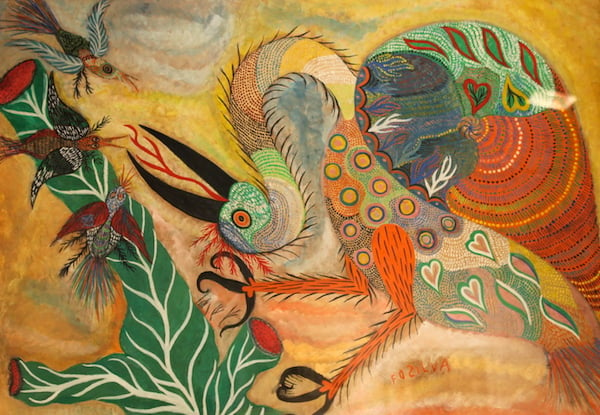
Saying that “outsider art” is an uncomfortable category is nothing new. A way of celebrating certain artists while at the same time stigmatizing them, the “outsider” category lumps together a lot of different things for unclear reasons. Still, it’s a successful brand, and the Outsider Art Fair—freshly moved to May from January to take advantage of the Frieze week whirl, and currently taking over three floors at 548 West 22nd Street in Chelsea—does a good job showing what makes it so.
As with any type of art, there are “outsider” superstars, and the Outsider Art Fair has ’em: Henry Darger, Martín Ramírez, Morton Bartlett. Ames Gallery has some amazing drawings by A.G. Rizzoli (1896–1981), fresh from being crowned an art star, of sorts, at the Venice Biennale. His crisply drawn “portraits” of neighbors and friends imagined as elaborate classical buildings, the architectural details and text annotations coding his thoughts about them, are a trip. They are probably worth the visit all by themselves.
Also as with any other type of art, there are patterns that become stultifying when it is shown in concentration: the fair offers a lot of obsessively detailed scribbling and elaborate constructions spun from humble materials. But in a way, the fact that it can all blur together from a distance just proves that it’s not the obsessive style itself that makes any of these artists interesting. For reasons unclear, transport is a common theme for those labelled as outsiders. But the lifesize cardboard sculptures of parking meters by Chase Ferguson—who hails from Harlem and is represented here by New York’s Pure Vision—are especially lovable, each amounting to a precisely constructed specimen of a historic meter (e.g. the “Dunkan Duplex Parking Meter”).
Parking meter sculptures by Chase Ferguson at Pure Vision
Photo: Ben Davis
The Brazilian Francesco da Silva (1910-1985) was born in the rainforest to a mestizo family and discovered gouache through an encounter with the Swiss artist Jean Pierre Chabloz—but he was evidently famous enough in his day to wow the likes of André Malraux and attract notice at the 1966 Venice Biennale, before falling on hard times in the 1970s. At Sao Paolo’s Galeria Estação, his vivid but elegant gouaches of tropical monsters stop you in your tracks. In da Silva’s case, the “outsider” umbrella just represents an ecumenical temperament that the “real” art world should have already embraced anyway.
And then there are figures like Stephanie Wilde, whose ornate acrylic and gold leaf paintings at Tanner-Hill Gallery radiate poise. The series, begun in 2008, is meant as an elegy to the honeybee in the wake of “colony collapse syndrome.” This very contemporary theme is given the stillness and ornate treatment of medieval illumination, with various canvasses drawing on the mythology of the bee from throughout history: one depicts Abigail, patron said of beekeepers; another brings in Egyptian bee iconography. All are graceful but carefully controlled. Wilde’s not an “outsider,” she’s just from Boise.
Stephanie Wilde’s Swarm II (2014) at Tanner-Hill Gallery
Photo: Ben Davis
My pass through the Outsider Art Fair was nicely framed by two encounters. One was with Daniel Baumann, a co-curator of the 2013 Carnegie International, who has put together a booth in partnership with San Francisco artist Aram Muksian. The whole space is wallpapered with a repeating graphic by the famous, Chelsea-approved British artist Sarah Lucas: pairs of breasts made from knotted-together cigarettes. Hung next to each other in the space are works by Dr. Lakra, a Mexican tattoo artist who has gained a fine-art following with collage-photos that apply his tattoo designs to vintage imagery (here a variety of fleshy black-and-white female nudes) and Lewis Smith (1907-1998), a self-taught artist from rural Ohio whose works show an obsession with female wrestlers, the suggestions of athletic action rendered in a kind of eerie cartoon stillness, in crayon outline.
The booth’s installation-like juxtapositions climax with a vast, wall-filling accumulation of documents from the late John Urho Kemp (aka Crystal John, 1942-2010), described as a “Californian researcher in metaphysics.” Hundreds of pages of pencil-drawn numerical speculation and graphs assaying the nature of the universe dominate one corner. “This is the first time any of this has been shown,” Baumann averred. All in all, the booth’s mixture of art cheerfully worked to assert that “outsider art” is just a fancy way of saying “art,” that is, the eccentric things people do with their passions.
Daniel Baumann with works by Sarah Lucas, Dr. Lakra, and anonymous
Photo: Ben Davis
The other important encounter came as I was leaving, when I ran into sculptor Lee Neary setting up a block down the street from the fair. The burly former construction worker was unloading colorfully painted wood carvings onto the sidewalk from his van. One is a stepladder labelled “SUCCESS,” the various steps labeled with different ideas of a stereotypical elite, the comfortable insiders: “Good Breeding” at the top, a “Proper Family” in the center, and a “Proper Death” at the bottom, this last marked by a carved green ghost. An outsider at the Outsider Art Fair, Neary said that he was part of a small community of artists who took advantage of the annual event to get their works in front of an audience who might appreciate them, which suggests to me that “outsider” art remains something that the literal man on the street can actually identify themselves in. “I sold out last time,” Neary said—though he added that he still had to keep an eye out for the cops.
Curbside sculpture by Lee Neary, outside of the Outsider Art Fair
Photo: Ben Davis
The Outsider Art Fair runs through May 11, 2014.